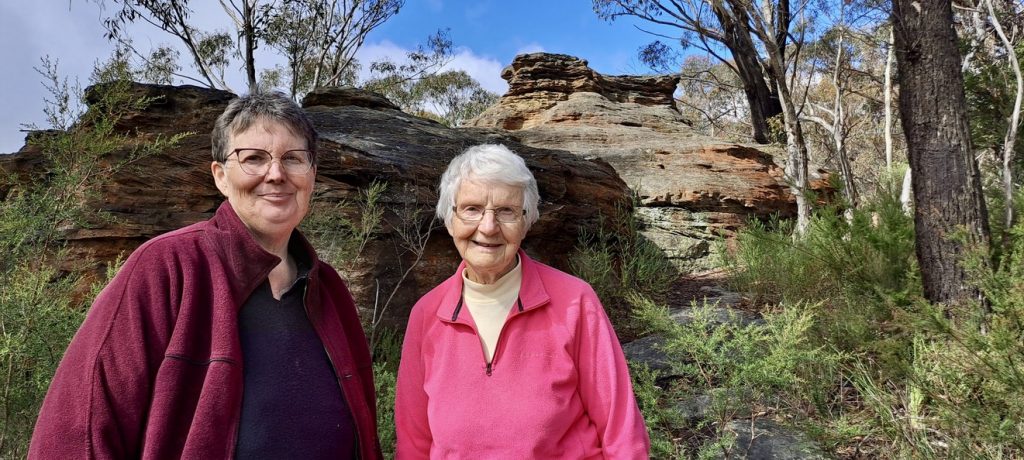
Suzanne Lollback (L) and Helen Drewe in front of a pagoda rock formation at Bracey Lookout.
By Tracie McMahon
Hassans Walls Reserve extends from South Bowenfels to the Vale of Clwydd, overlooking the town of Lithgow to the North and Hartley Valley to the South. It was gazetted for public recreation in 1882 as 143 hectares managed by community. Over time the reserve increased with successive land grants and transfers including 572 hectares from the Lithgow Valley Colliery Company in 1978. Today, the reserve comprises 770 hectares and is managed by Lithgow City Council as the appointed Crown Land Manager.
At the height of the Great Depression, walking and vehicle access tracks were built to provide employment for locals affected by the 1928 closure of the steelworks. Some of these remain, others have been destroyed by mining subsidence and landslides.
This network of tracks introduced me to the reserve as a teenager, running and cycling. Now in my slower years, I walk the reserve and am continually astonished at the flora and fauna I find.
I am not alone. My knowledge of the distinctive range of species found on the reserve came from Native Plants: Hassans Walls Reserve Lithgow. This book was my entry point into native species identification. With this trusty A5 guide in my pack, I’d go exploring. The wildflower chapter is one of my favourites. It is colour coded and includes common and botanical names.
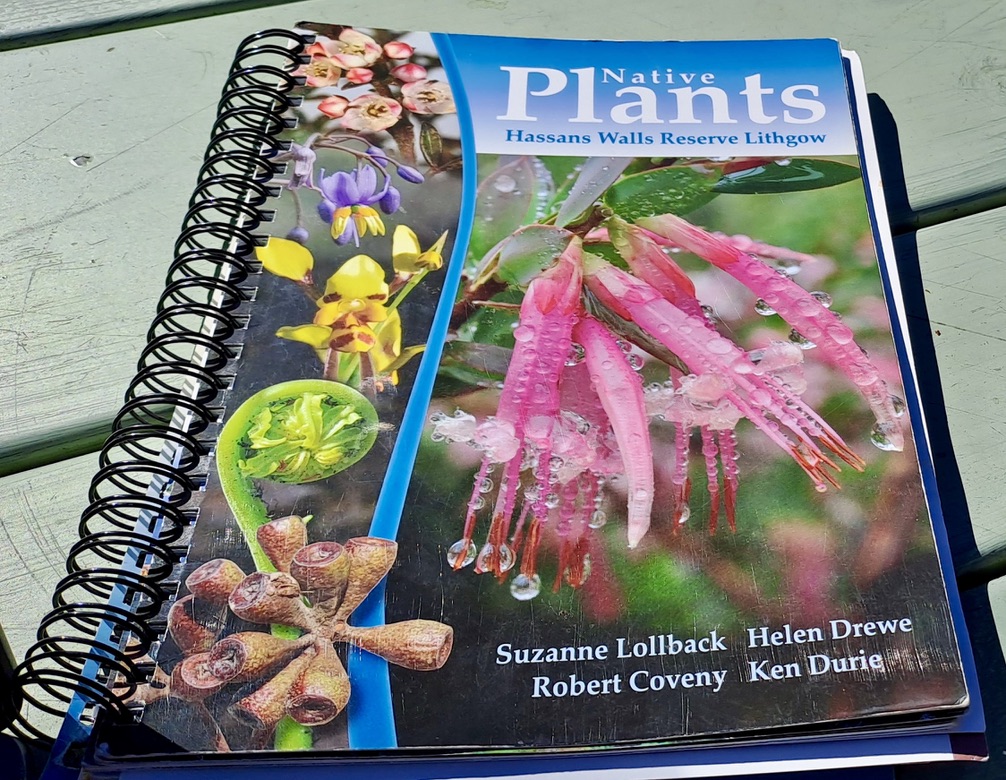
My much-loved copy of Native Plants: Hassans Walls Reserve
I have asked Helen Drewe, one of the co-authors of the book, to join me for a bushwalk. There is a misty rain hovering over the escarpment on the day we meet. I arrive late to Bracey Lookout, having slowed down on the unsealed road for a lyrebird! I’m thrilled to find Suzanne Lollback, another of the co-authors, has joined us. These two could show me more in ten minutes on the reserve, than I would find in hours of walking on my own.
The mist morphs into a heavy shower and we huddle in Helen’s car and wait for the weather to pass. Helen tells me she has been walking here with her family since she arrived in Lithgow in 1981, and started exploring it more extensively in her retirement, intrigued by its unusual diversity. She began leading walks on the reserve with the Hoskins Church Beehive Group. There was a lot of interest, so in 2010 she produced a pamphlet and CD with photos of 25 orchids she had found on the reserve.
Suzanne Lollback was working with Lithgow City Council at the time and had noticed Helen’s work. By chance they ran into each other while searching for orchids. Suzanne was quick to introduce herself and soon they were meeting and walking regularly.
Co-author Ken Durie was a keen photographer and member of Helen’s Beehive walking group. Ken and his wife Pat became an invaluable part of the team, exploring the reserve and furthering their fascination with orchids. Helen recalls they would all race home to share news of their latest ‘find’ with each other. As they collated, verified and documented their sightings, they realised they had recorded over sixty different species in a twelve-month period, an ‘unheard of’ diversity in such a small space. They felt it was time to share the news and raise awareness to preserve this unique space.
In 2012, they self-published a 37 page book Hassans Walls Orchids. At the time it was the only publication dedicated to orchids in this region. They sent a copy to Sydney’s Royal Botanic Garden, where it came to the attention of Robert Coveny, a botanical collector at the National Herbarium of New South Wales. He was impressed, and on retirement began exploring with this team of orchid enthusiasts.
With Robert’s extensive knowledge, the team decided to publish a new 161 page book Native Plants: Hassans Walls Reserve Lithgow (2014). It covered orchids and also flora and fauna from the understorey to the canopy. The first print run sold out within twelve months. Helen and Suzanne frequently meet people coming to Lithgow to search out species they have read about in the book.
The authors are awaiting the release of an updated edition due out in June. It includes areas surrounding Hassans Walls and many new species.
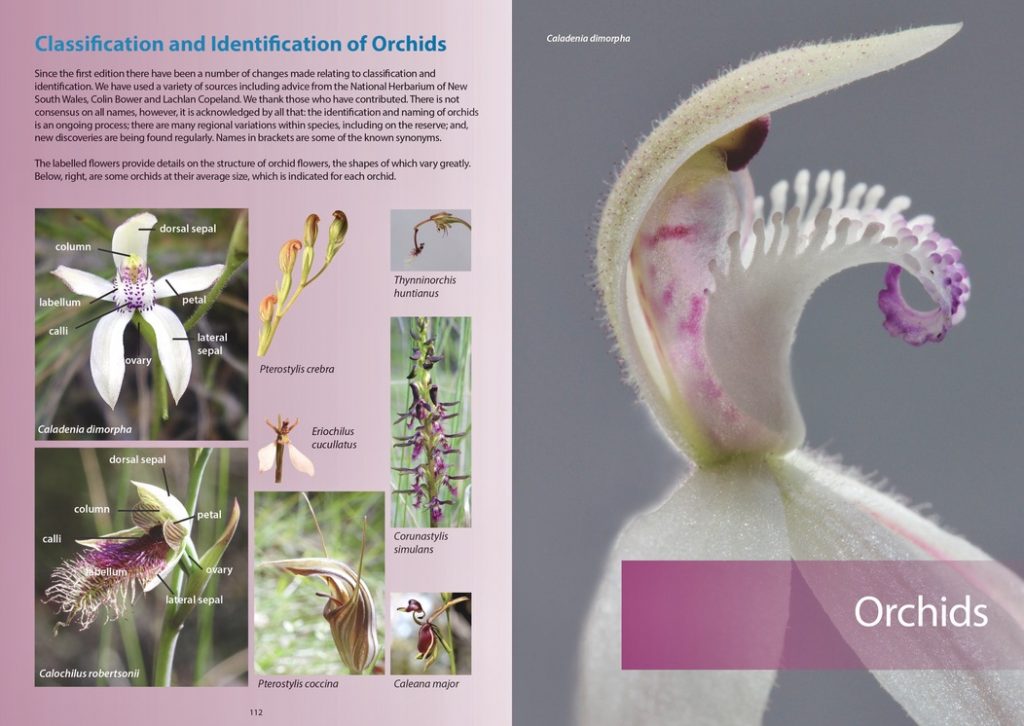
Excerpt showing the photography and detailed information in the updated edition (supplied by Suzanne Lollback)
The weather clears and we head off on our bushwalk. While the sun squints from behind grey clouds, Suzanne stops to identify eucalypts. She rubs her hands over the bark of Eucalyptus mannifera and shows us the powdery sheen on her fingers: the tell-tale sign for this species.
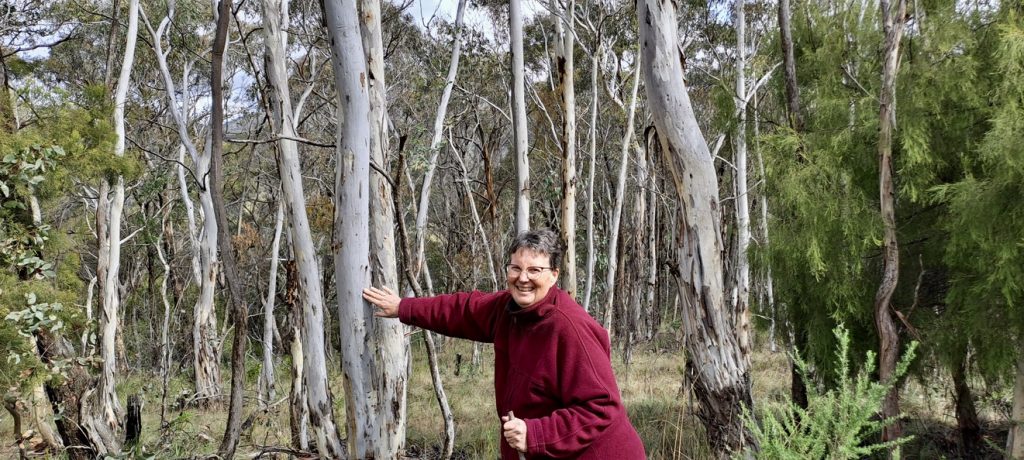
Suzanne Lollback, demonstrating how to identify Eucalyptus mannifera
We continue towards the water tank, and Helen and Suzanne point out places where orchids have been found in the past. There are tiny green stems in the leaf litter, which are the orchids’ pre-flower. Then we spot a bunny orchid in flower (also known as Leafless Parson’s Bands, Eriochilus cucullatus).
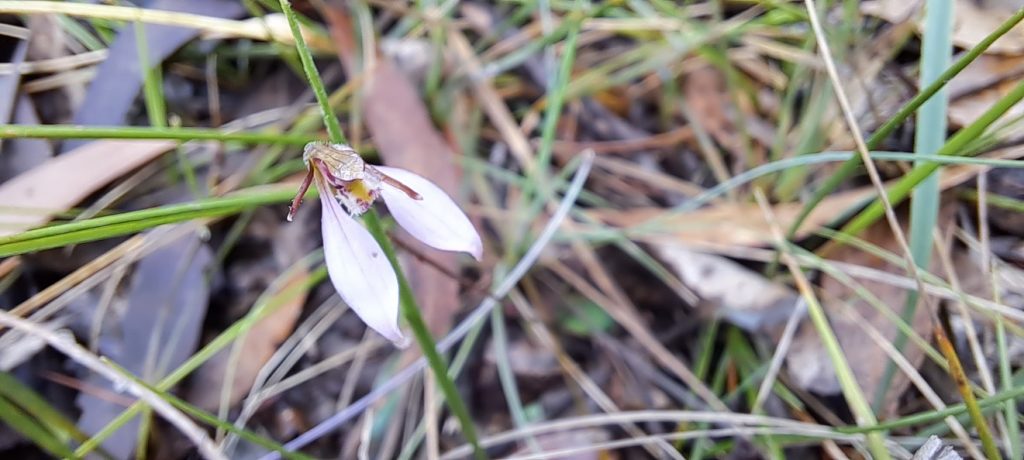
Eriochilus cucullatus (also known as Leafless Parson’s Bands or Bunny Orchids)
I remark on the abundance of Sunshine wattle (Acacia terminalis), readying itself for a winter display. Helen tells me it is brighter here than in the neighbouring Blue Mountains. The reserve has a unique geology, she explains, resulting in unusual variations in flora. It is the western most sighting of traditionally Blue Mountains species such as Hakea dactyloides and eastern most recording of western species such as the rare orchid Caladenia fitzgeraldii.
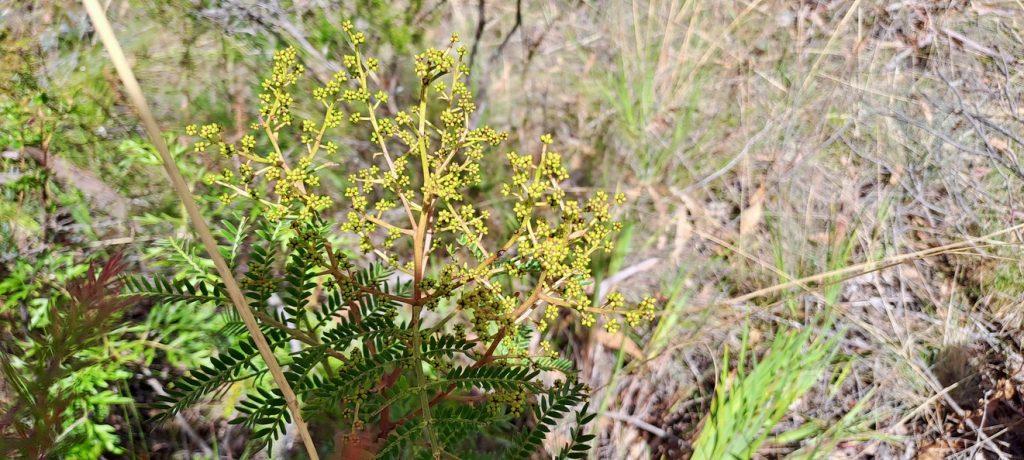
Acacia Terminalis (also known as Sunshine Wattle)
In less than 100 metres we find an abundance of plants, from the common to endemic. Suzanne and Helen readily answer my rapid-fire questions. I wonder if they were ever concerned about the attention their book might draw to rare and endangered species. They did consider this, but drew inspiration from the endangered Purple Copper Butterfly, endemic to Lithgow. It was publicity about the butterfly that raised awareness of the importance of pollinator species, which ensured protection of plants and habitat critical to the survival of the butterfly, throughout Lithgow.


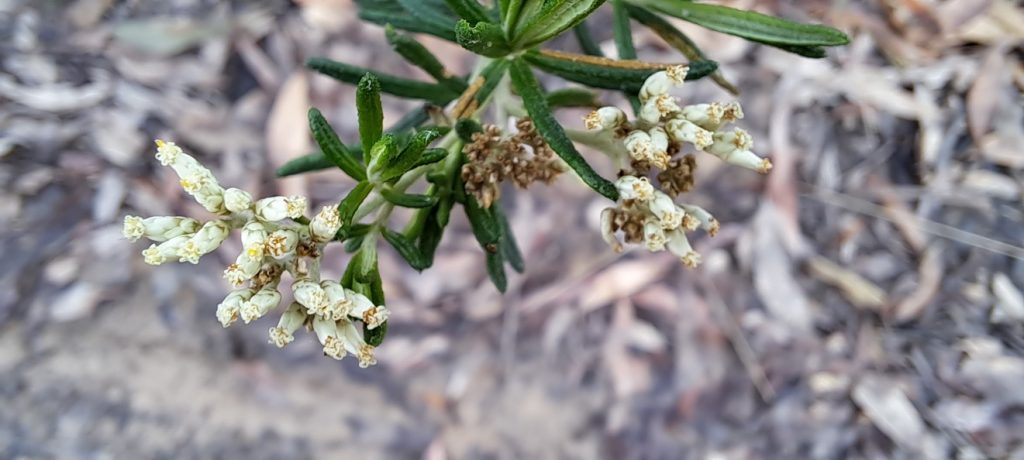
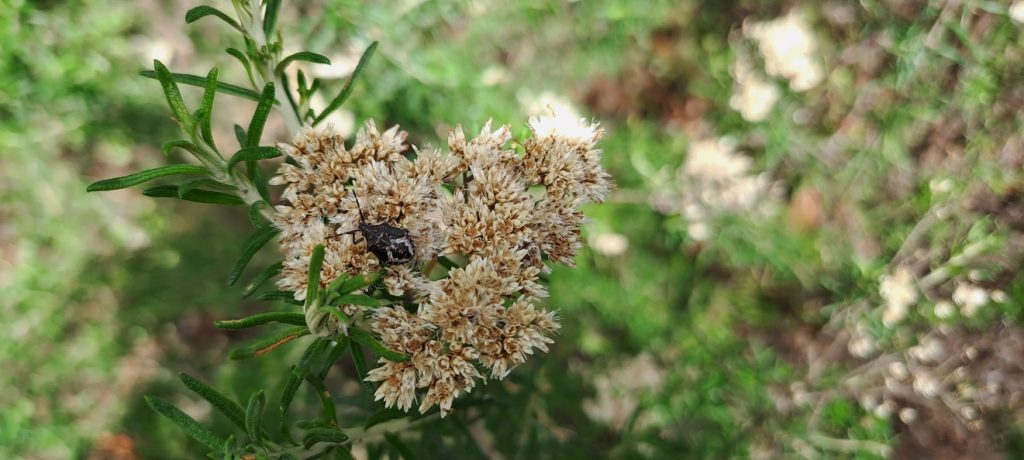
Some of the flora and fauna on our walk
In a short distance, we pass a variety of plant communities. To the north an open forest woodland features towering trees. To the west in a sheltered gully, an understorey of wattle, daisy and tea-tree merges with ferns and grasses. This small section of landscape is dissected by sealed and unsealed roads, tracks and a transmission tower. Helen and Suzanne tell me about a mass orchid bloom behind the security fencing around the water tank. It seemed incredible to me that such an array of plants could survive on an urban fringe.
They say it is “a matter of balance” but are concerned about the consequence of high impact activities. Suzanne explains, “the environment on Hassans Walls Reserve is too small and too vulnerable due to its peninsula environment to be able to sustain major impact such as those that can be incurred by large scale or extreme activities.” She makes a point of clarifying her position: “I am not against such activities, and believe there is a place for them, however proper assessment must be undertaken to ensure that impacts from any activities on the reserve are minimal and conservation is sustainable. Low impact activities that respect the natural environment do not cause damage. It is only when people step off or create new tracks, that irretrievable damage occurs.”
Helen and Suzanne say this is one of the key reasons for publishing their books: to create awareness. They hope their new book becomes a “reference manual for native plants” which users are required to consider before being authorised to use the reserve for large scale activities.
The clouds lower, delivering yet another shower and we make a hurried return to our cars. I thank them, voicing my enthusiasm to return and explore the maze of pagoda rock formations and gullies with my newfound knowledge. They smile and wave, reminding me that is why they joined me today: to spread the word.
As the preface to their 2014 book, says: “Our hope is that you will discover some of these gems for yourself, not only to enjoy but to assist in their preservation by valuing and protecting their habitat.”
If you would like to explore the reserve, it is easily accessible by 2WD car, from either Hassans Walls Road past the Coles Shopping Complex in Lithgow or Browns Gap Road, prior to the road closure barricades. There is also a marked 30 minute walking track at the top of Eskbank Street, which leads to Bracey Lookout.
You can pick up copies of their books from the Lithgow Visitor Information Centre, National Parks and Wildlife Offices and range of bookshops such as Megalong Books and the Botanical Bookshop.
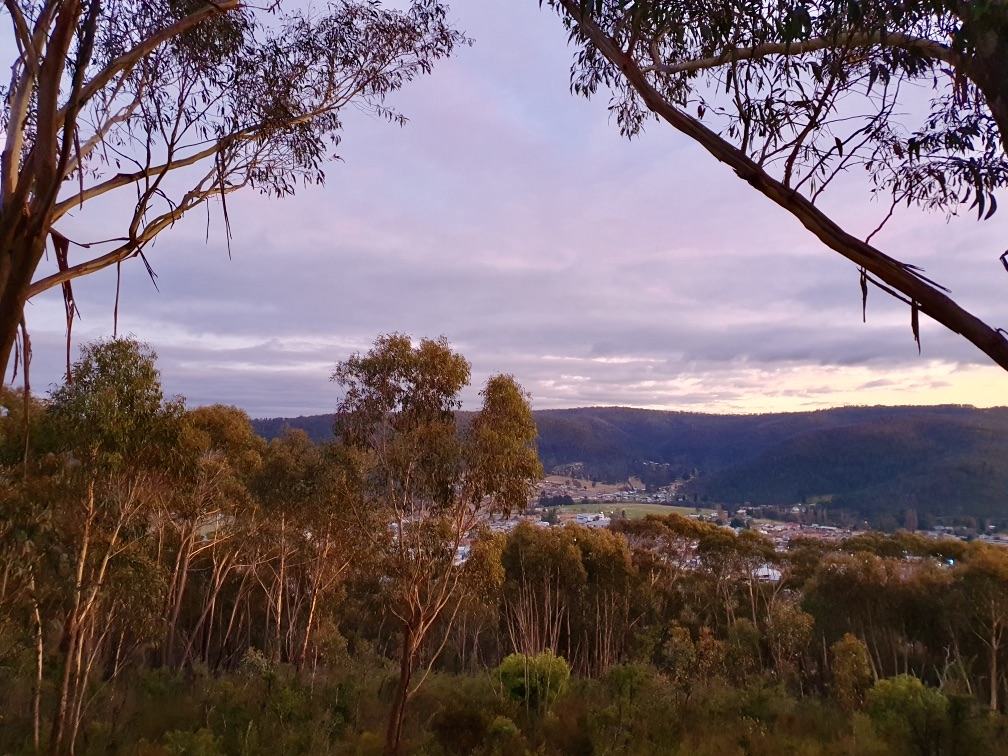
Sunrise over Lithgow from Hassans Walls Reserve. June 2023. (Credit. Ross Gurney)
This story has been produced as part of a Bioregional Collaboration for Planetary Health and is supported by the Disaster Risk Reduction Fund (DRRF). The DRRF is jointly funded by the Australian and New South Wales governments.


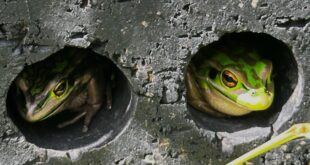


One comment
Pingback: Postcards from the Past, Present and Future - Lithgow Area Local News